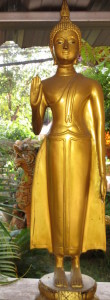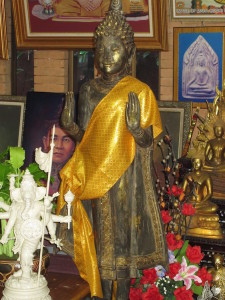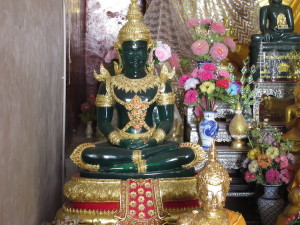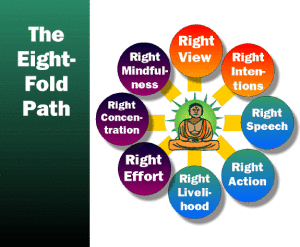Chiang Mai has at least 16 different wats or temples, all built by or for some royalty in the history of Thailand (which has also been called Siam). In all of these temples are various symbols mostly originally from Buddhism or stories about Buddhism, and also to some extent Hinduism. The distance from Chiang Mai to Kolkata is just a bit over 700 miles, about the same distance from Detroit to Boston, or San Francisco to Tucson. So it’s not too surprising that the strong Hindu culture has had influence here too.
During my meditation retreat at Doi Suthep, I had a chance to wander among the dozens of statues and icons that filled that wat. Buddhas of many forms, expressions, colors, even materials. And within that variety were many different positions and hand gestures. When you encounter something new, all the variety blends together into a kind of mush –“oh look, another gold Buddha!” Being the curious guy I am, wanted to know more. Surely there was SOME reason why one Buddha was standing with his hands up palms facing out, and the next Buddha was sitting with his hands folded in his lap. And so the purpose of this blog entry is to tell you what I learned. All of this material is on the web in much more learned and undoubtedly accurate form. But this is MY journey, so all the explanations and pictures are mine.
In the previous post, I offered up a short intro to Buddhism. Most of the Buddha iconography was created to illustrate some aspect of The Four Noble Truths for followers; most aim to help followers follow the Middle Path. They also have a significance related to an important event in the life – or past lives – of the Historical Buddha.
First we’ll look at the four major body positions found in Thailand, and then we’ll dig into some of the gestures, or mudras, that I found.
The Buddha is presented in 4 positions (not related to the 4 Truths).
The Buddha is shown sitting whenever he is meditating or teaching the Dharma, which is the Buddhist understanding of the Nature of Life.
According to the stories, upon attaining enlightenment, the Buddha stood under the Banyan tree for 7 days, contemplating the suffering of all beings. Often, standing Buddhas reflect this time in his life.
(Aside: I got confused about the difference between the Banyan Tree and the Bodhi Tree, both peppered around Buddhist stories. Here’s what I found out, but please tell me where I’m wrong. The historical Buddha sat under the Bodhi Tree (Ficus religiosa) when he attained enlightenment (the word “Bodhi” means “enlightenment), and then he stood for 7 days under the Banyan Tree (Ficus urostigma) to contemplate the suffering of all beings with this newfound enlightenment. (more)
The reclining Buddha depicts the Buddha in his last few moments on earth, before dying and entering Nirvana. If he is using his hand to hold up his head, then he is merely resting, moments before dying. If his head is laying on the ground, then he is dying or gone.
When the Buddha statue is walking, it represents a time when the Buddha was returning to earth after delivering a sermon on the Dharma in Heaven. This position is shown with the Buddha standing with the right foot behind the left, starting to raise off the ground. We were taught this way of walking in my retreat.
Within each position, the Buddha is shown holding his hands in certain ways or gestures (called mudras in Sanskrit for “token” or “sign”). There are many, many mudras across the Buddhist world (see here), but I’ll just focus on the ones I actually saw here in Thailand. These are:
| Sanskrit Name | Meaning |
| Abhaya | Gesture of Imparting Fearlessness & Protection |
| Anjali | Gesture of Greeting and Adoration |
| Bhumisparsha | Gesture of Touching Earth – Enlightenment |
| Dhyana | Gesture of Meditation |
| Karana | Gesture of Warding off Evil |
| Vajrapradama | Gesture of Unshakable Self Confidence |
| Varada | Gesture of Compassion and Granting Wishes |
| Vitarka | Gesture of Teaching |
Abhaya Gesture of Imparting Fearlessness, Protection, and Reassurance
 |
 Double Abhaya |
Description:
Right hand up at chest level, palm facing forward. Sometimes the left hand resting on left thigh, in the lap, palm facing up, and sometimes the left hand is also at chest level, palm facing forward. Mostly I’ve seen both palms facing forward in Standing Buddhas, and one palm facing forward in Sitting Buddhas (which sort of makes sense since a sitting Buddha has a lap to place the left hand.)
Meaning:
Gesture of Imparting Fearlessness and Reassurance.
The idea is that the open palm shows a hand empty of weapons, and therefore is the sign of friendship and peace. It also looks like a “stop” signal to an enemy (as my guide in Cambodia explained). So in both interpretations, it means fearlessness.
According to tradition, the Buddha made this gesture immediately after gaining enlightenment. And later, when he was about to be attacked by an angry elephant, he held up his hand in the fearlessness gesture and immediately calmed it. So if you’re ever attacked by an angry elephant, you know what to do! (more)
Anjali Gesture of Greeting and Adoration (also known as Namaskara or Namaste)
Description:
Palms together at forehead or heart. Why? Because only with the heart, or with a deeper spiritual insight (third eye, which is at the forehead) can one truly see that we are all expressions of the same Divine force.
Meaning:
Gesture of Greeting and Adoration
Anjali means “double handful”(cite), and translates from Sanskrit to “offerings” (cite). The gesture is offered as a greeting of great respect for the Divine in all. Using two hands in Anjali expresses the co-existence of two worlds that form a duality: the spiritual and the material world, as well as the static and dynamic nature of things.
A note: Because this is a gesture of homage, you never see a statue of Buddha doing it, only followers who have attained enlightenment (called bodhisattvas). This is because the Buddha IS the one with all the power and light and divinity. One doesn’t show homage to oneself, now does one? (Well…)
Interestingly, the Thai people today use the Anjali when they express wai, which is a greeting to almost everyone. Where Westerners might shake hands in greeting, Thais do wai instead. Thais do wai everywhere; the counter clerk even shows me wai (the Anjali gesture), after I buy a bag of popcorn at the movies, and my golf caddy, aptly named Pin, does wai for me at the end of my round when I tip her (of course, given her excessively optimistic scoring of my game, I should be expressing my high respect and adoration for her).
Bhumisparsa Gesture of Enlightenment
Description:
Right hand is palm down, bent over the right knee. And ideally the fingers are touching the ground (earth). The left hand lies in the lap, palm facing up.
Meaning:
Gesture of Touching Earth, Gesture of Enlightenment
Bhumisparsa was reported to be the gesture the Buddha showed the moment he attained enlightenment, and so for contemporary Buddhists, symbolizes the hope for their own enlightenment. (If I get that far, I imagine mine will be a self smack across the forehead. Doh!) This gesture expresses the strength and truth of his commitment to enlightenment, which helped him overcome all the temptations and darkness (Mara) that came to him right before enlightenment.
“During meditation, Siddhartha is subjected to many temptations, many posed by the evil Mara, who bombards him with his demons, monsters, violent storms as well as his three seductive daughters. The Buddha remains steadfast! Then, to testify to Mara of his meritorious past, he points to the earth with his hand and calls the Earth Goddess, Thorani. She rises from the ground and wrings the water from her long black hair, by this action raising a torrential flood that drowns Mara and his army of demons.“ From here.
Note: Before the historical man became known as the Buddha, he was a Northern Indian prince named Siddhartha Gautama. Herman Hesse’s novel “Siddhartha” which I really enjoyed is, I think, one accessible account of how the Buddha came to be.
By all accounts, and my own experience, Bhumisparsa is easily the most common Buddha gesture in Thai wats.
Dhyana Gesture of Meditation (Also known as Samadhi )

An “Emerald” Buddha, replicating the original Emerald Buddha which sits in Bangkok. The original was created in, some say, 40 BCE.
Description:
Both hands in lap, palms facing up. Right hand rests in left hand. Sometimes the thumbs touch, forming a triangle which is seen to be the circle of energy. Usually in a sitting Buddha.
Meaning:
Gesture of Meditation
This mudra signifies meditation and contemplation, one of the primary practices that Buddhists use to follow the Middle Path. The Bodhisattva makes a vow and is determined not the leave the spot (where he is sitting on the grass) until he achieves enlightenment. The Bodhisattva determines to find the cause of suffering and its cessation.
Sometimes the Dhyāna mudrā is used in certain representations of Bhaiṣajyaguru as the Medicine Buddha, with a medicine bowl placed on the hands.
For your meditation practice, you use this mudra inspire you to get deeper contemplation with higher energy.
Karana Gesture of Warding off Evil and Expelling Negativity
Description:
Right hand up and palm facing out, middle finger and ring finger crooked, middle finger touching thumb.
Meaning:
Gesture of Warding off Evil and Expelling Negativity
The karana mudra expresses a very powerful energy with which you can get rid of any negative energy you carry, like sickness, negative thoughts, anger, etc. If you sense evil coming your way, you can also use it to ward it off. Which is nice. More generally, the karana mudra is used to overcome any mental obstacles you have in your life. “You can sense a very determined, focused energy just by looking at this hand gesture.” As with other mudras, you can recite mantras slowly and intentionally. Here are two suggested mantras for Karana.
“May obstacles be removed.”
“May negative energy be thwarted.”
(I always have liked the word “thwart”)
Vajrapradama Gesture of Unshakable Self Confidence
Description:
Hands folded on chest, typically on standing Buddha.
Meaning:
Gesture of Unshakable Self Confidence
Vajrapradama expresses the kind of self confidence that doesn’t come from ego, or arrogance or even personal competence. It comes from the realization that we are at peace because we are at one with peace. This is the Buddhist idea that we are all connected, we are all part of Divine Life, and that we can draw self confidence from that realization, rather than from individual and personal achievement. So it’s confidence in the Self that is part of the Divine. Nice phrase I found: “When this confidence is there, the Heart becomes the strongest communicator.”
Varada Gesture of Compassion and Granting Wishes
Description:
Usually the left hand palm up of the left hand. . This mudra is made with the left hand, palm up and most often with other gestures, such as the Bhumisparsa or the Abhaya mudras.
Meaning:
Gesture of Compassion and Granting Wishes
Varada mudra expresses the energy of compassion, liberation and an offering of acceptance. It also is the mudra of the Buddha’s charity, and is the gesture of dispensing the kind of favors you’d want to get from an enlightened being (no, not winning lottery numbers).
The right hand is directed downward with palm open to the viewer, empty; fingers may be slightly bent as if to support a round object. If standing, the arm is slightly extended to the front. If seated, hand remains at breast level, a little to side, palm up, and often the other hand holds a corner of the kesa.
Varada represents offering, giving, welcome, charity, compassion and sincerity. It is the mudra of accomplishment of the wish to devote oneself to human salvation. The open hand and extended fingers symbolise the flowering of the Buddha’s Gift of Truth.
Varada is frequently seen combined with Abhaya mudra, where right hand makes the gesture of fearlessness, the left of wish granting. Standing Buddha figures often show abhaya and varada together.
Vitarka Gesture of Teaching
Description:
The hand is held closer to the chest than in the Abhaya mudra. The palm faces outward. The index finger and the thumb make a circle. The other three fingers point upward. Initially made with just the right hand, later on in history the gesture became often expressed with both hands.
Meaning:
Gesture of Teaching
Vitarka mudra evokes the energy of teaching and intellectual discussion, or argument. It mostly feels like the transmission of a particular teaching with no words, and the circle formed by the thumb and index finger creates a constant flow of energy/information. Close to Abhaya mudra , the energy created by this hand gesture allows for a transmission of knowledge in a protected way, without being impeded by fear.
And….that’s it for now. There are probably more mudras that I didn’t see, but because I didn’t see them, I’m not reporting on them.
There are also many different icons and assorted symbols in Thai wats, and my next post will cover them. Stay tuned for Ganesha, the Fat Buddha (who isn’t really a Buddha), Thorani, and more!
Can you add (or correct) anything you know about these mudras?
The next 3 posts will be about Buddhism.
Part 1 is a short intro to Buddhism off the top of my head, for those who know little about it, at least as I practice it.
Part 2 is a study of all the types of Buddha statues and iconography that I’ve found in scouring Northern Thailand temples: fascinating for me, and I hope you too!
Part 3 is a study of all the iconography I found in the temples that are NOT Buddha, which are fascinating in their own right.
In this first part, to illustrate how I “use” Buddhist principles, I also let you in on my very personal divorce recovery story.
Around the 5th century BCE an Indian prince named Siddartha Gautama became disenchanted with his privileged life in Northern India, reportedly after seeing someone dying. So he left his wealthy family and sumptuous, well-bubbled home, and began a quest to look for the answer. As you might imagine “stuff happened” which I won’t describe since it’s described so much in other places (see Herman Hesse’s book “Siddhartha” for a good fictional Western interpretation). One day, after much contemplation, Siddartha attained enlightenment and in that instant became the Buddha. The word “Buddha” means “awakened one” in Sanskrit. The Buddha’s teachings spread throughout India and then on to East Asia, getting assimilated in Japan alongside Shintoism, in China with Confucianism, and in SE Asia. Thailand, for example, is a deeply Buddhist country, even giving Buddhist monks special lines and sitting areas in airports. (More on the history of Buddha here.)
To understand my next two posts about the iconography of Thai Buddhism, it helps to understand a little bit about Buddhist principles, because the variance of the statues is due to the effort to express the different aspects and nuances of these principles, as well as the life of the historical Buddha. I won’t go too deep, but most forms of Buddhism start with the Four Noble Truths about life. The interpretations are all mine, and my learning of these is really just starting. And, as promised at the outset of this post, and at the risk of making some of you uncomfortable, I offer up a (formerly) painful personal example to make my experience with each Noble Truth more illustrative!
The Four Noble Truths (by Buddha)
Let’s look at these a bit more closely.

Those are the Four Noble Truths of Buddhism and most of the statues and depictions of Buddha have something to do with some aspect of them, most concerned with helping followers follow the Middle Path. They also have a significance related to an important event in the life – or past lives – of the Historical Buddha.
So I’ve told you all that to set up the next two posts about the iconography I found in Thai wats. Coming very soon!
Before we get there, though, if you have any corrections, clarifications, amplifications or thoughts of any kind to what I’ve written here, please add them in so I can learn more. Thank you!
